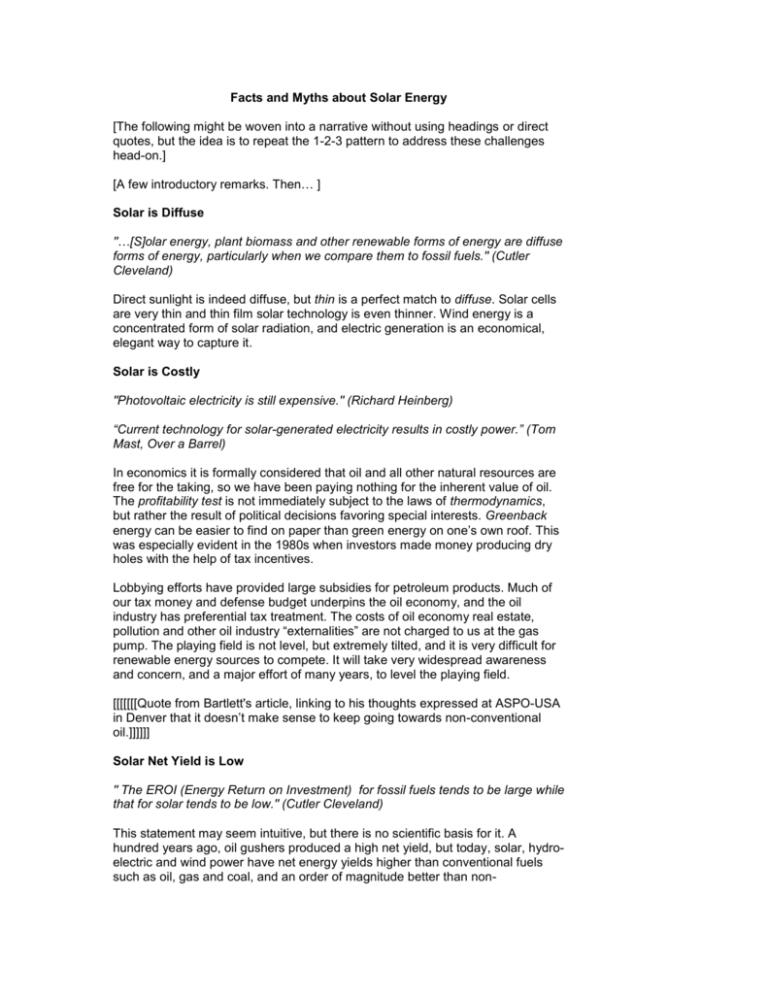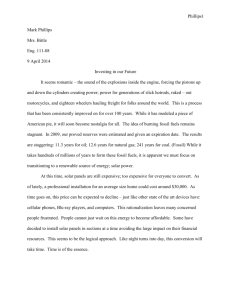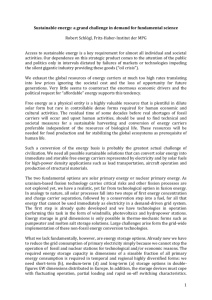Myths about Solar Energy
advertisement

Facts and Myths about Solar Energy [The following might be woven into a narrative without using headings or direct quotes, but the idea is to repeat the 1-2-3 pattern to address these challenges head-on.] [A few introductory remarks. Then… ] Solar is Diffuse "…[S]olar energy, plant biomass and other renewable forms of energy are diffuse forms of energy, particularly when we compare them to fossil fuels." (Cutler Cleveland) Direct sunlight is indeed diffuse, but thin is a perfect match to diffuse. Solar cells are very thin and thin film solar technology is even thinner. Wind energy is a concentrated form of solar radiation, and electric generation is an economical, elegant way to capture it. Solar is Costly "Photovoltaic electricity is still expensive." (Richard Heinberg) “Current technology for solar-generated electricity results in costly power.” (Tom Mast, Over a Barrel) In economics it is formally considered that oil and all other natural resources are free for the taking, so we have been paying nothing for the inherent value of oil. The profitability test is not immediately subject to the laws of thermodynamics, but rather the result of political decisions favoring special interests. Greenback energy can be easier to find on paper than green energy on one’s own roof. This was especially evident in the 1980s when investors made money producing dry holes with the help of tax incentives. Lobbying efforts have provided large subsidies for petroleum products. Much of our tax money and defense budget underpins the oil economy, and the oil industry has preferential tax treatment. The costs of oil economy real estate, pollution and other oil industry “externalities” are not charged to us at the gas pump. The playing field is not level, but extremely tilted, and it is very difficult for renewable energy sources to compete. It will take very widespread awareness and concern, and a major effort of many years, to level the playing field. [[[[[[[Quote from Bartlett's article, linking to his thoughts expressed at ASPO-USA in Denver that it doesn’t make sense to keep going towards non-conventional oil.]]]]]] Solar Net Yield is Low " The EROI (Energy Return on Investment) for fossil fuels tends to be large while that for solar tends to be low." (Cutler Cleveland) This statement may seem intuitive, but there is no scientific basis for it. A hundred years ago, oil gushers produced a high net yield, but today, solar, hydroelectric and wind power have net energy yields higher than conventional fuels such as oil, gas and coal, and an order of magnitude better than non- conventional fossil fuels including enhanced oil recovery, tar sands, oil shale, coal-to-liquid, and LNG. To guide policy, it is appropriate for the solar energy community to cooperate with other industries to develop a fair and open protocol to compare net energy and global warming impacts for all alternatives to oil. Solar Can't be scaled “At the moment, solar and wind power are developing in specialized areas. Neither is an immediate, large-scale solution to the energy problem.” (Kenneth S. Deffeyes, Hubbert's Peak) “But all of them combined -- sun, wind, and water -- could never produce enough energy to replace the astronomical amounts of fossil fuel the West is accustomed to consuming now." (Pierre Chomat, Oil Addiction: The World in Peril) Humanity’s “primary energy production,” including all fossil fuels, nuclear power, hydroelectric and renewables, is 13.5 TeraWatts, less than 1/100 of 1% of the 178,000 TeraWatts continuously delivered to the earth as sunlight. With their inherent high net energy yield, renewables can be ramped up rapidly. This must be clearly demonstrated in the near term. There may not be enough fossil fuels remaining for humanity to experiment twice: first with marginal fossil fuels while the second inevitable step, the transition to renewables, is delayed. BioMass is inadequate, low net yield “But plants, on average, capture only about 0.1% of the solar energy reaching the Earth. This means that the actual plant biomass production in the United States is just 1.6*10^10 Btu per square mile per year... (Cleveland) In the USA, 1 billion tons of biomass are managed each year. To meet all our energy needs 7 billion tons more would be required. Therefore, biomass must necessarily be a small part of the total. Liquid fuels exclusively from plant material would only be possible by cutting liquid fuel usage worldwide to about one-tenth of the present level. Solar won't work for Transportation “... The amount of solar energy that falls on a car yields very marginal performance...” Tom Mast, Over a Barrel While there are attempts being made to find other substitutes for oil, renewable energy in its various forms offers humanity the only feasible alternative. This is a surprising conclusion given that over 50% of all oil globally (and nearly 70% in the USA) is presently used as liquid fuels for transportation. In this context, how could renewables such as photovoltaics or wind generation possibly contribute meaningfully to transportation energy? [Incomplete. Balance with the main article, derived from the material which follows] Transportation in a World Beyond Oil "Higher energy densities also contribute to the higher EROI for fossil fuels relative to many renewable fuels." (Cutler Cleveland) The premise of converting solar field energy into fuel in the first place has to be challenged. Solar energy can’t be touched or put into a bottle. Solar is field energy, not a solid, liquid or gas. The same can be said for electricity (field energy) and ideally suited for urban transportation. In the bargain, it is nonpolluting, much more efficient, well-suited for fixed guide rail and automated routing of traffic. A direct path from sunlight to electricity is ten times as efficient as photosynthesis, and taking it one step further, an electric vehicle is at least twice as efficient as a gasoline vehicle. Considering society’s huge investment in the vehicle fleet and the marginal yield of biomass fuels, it is difficult to imagine the transformation of transportation to renewable energy sources. While we are unlikely to see electric airplanes or cargo ships anytime soon, the prospect of electric urban transport is not simply advantageous for curbing pollution. It is essential to the preservation of modern society. We are ready for a good excuse to get rid of the internal combustion (IC) engine in dense urban areas. The IC engine is about as practical in Manhattan, Mexico City or Tokyo as a campfire in the urban kitchen. [Integrate and trim some.] And, just as solar cells continue to improve, so do the enabling technologies for electric vehicles. A battery is available on the market with 3 times the energy density of lead-acid. A battery with similar density has been announced with a charging time under 2 minutes, scheduled for introduction in 2007 or 2008. The electric drive train of the Toyota Prius has met the test of time and its sophistication bears witness to the potential to deliver on the promise.] [What about “The Hydrogen Economy?” While hydrogen by electrolysis from renewable electricity is offered as an alternative to liquid fuels, the round-trip efficiency from electricity to hydrogen by fuel cell back to electricity cannot possibly be as efficient as electricity directly applied.] [optional] Sun, wind, geothermal, and other renewable electricity sources cannot directly replace high energy density liquid petroleum for transportation use; instead automobiles and other equipment must be altered to allow using electricity (in batteries) or hydrogen (via fuel cells or internal combustion) which can be produced from renewable sources. (Wikipedia)








